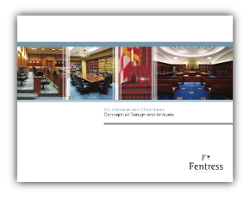It is always an exciting day when the doors of a new courthouse open. There is a feeling of accomplishment in seeing the shared vision come together, and a sense of efficiency in moving into a building that meets the needs of all occupants. Most often, a new courthouse can be designed to house the entire court family under one roof, which provides many benefits and allows for optimal functionality.
However, as time goes on, the space needs of the courthouse occupants grow. When space becomes too tight to accommodate all personnel and operations, one or more court components must be moved to another government building or into leased space. This presents many operational challenges for the court family.
When a court divides into multiple buildings within a city, we call this court fragmentation. Approximately 80% of the courts I’ve worked with have been fragmented. Below I examine some impacts of fragmentation, ways to avoid it, and ways to reduce the operational impact when there’s no alternative but to fragment.
Compromises for the Public
One of the most observable impacts of fragmentation is the confusion it can cause for members of the public. Courts exist to serve the people, and a courthouse is usually one of the most prominent public buildings in any community, serving as a landmark and civic space. But when court fragmentation occurs, there is no longer one single building to find and navigate. The public must find the correct building, sometimes among several, for the proceeding or service they need.
I once worked with a court that was fragmented into eleven facilities. Courtrooms were located in five of these eleven facilities. Imagine the confusion of the public in trying to figure out which building to go to. The security personnel in the lobby received endless questions about directions, as did personnel from other departments on the first floor. In addition, there were constant complaints about court participants showing up in the wrong building. This situation frustrated both the public and the employees who received so many distractions from their primary job responsibilities.
As a court planner with a deep understanding of functional court layouts, I even find it confusing to locate the individual units when the functions are dispersed. I usually have a point of contact from the court who can help me navigate the facility, but that is not the case for the public and other court participants.
Compromises to Security
A second impact of fragmentation is the problems it can create with security. When the court family is in a single courthouse, security resources can be centralized and optimized. Security provisions include the lobby screening area, command-and-control station, prisoner management, courtroom security, and roving security throughout the building. All of these require personnel, space, and equipment.
As the court fragments into multiple facilities, so does security. In the best-case scenario, the number of security personnel can be increased to meet the needs of a dispersed court. However, when budgets are tight, this is often not possible, and security personnel must be divided between the facilities.
This situation is extremely critical when there are criminal court proceedings in multiple facilities. The number of security staff must increase to effectively manage prisoners and functions in separate facilities. When not properly staffed, a courthouse is left vulnerable and the risk of prisoner-related security problems increases.
Compromises to Court Operations
A third impact of fragmentation is the negative effect on court operations, especially when the fragmentation leads to a delay in court proceedings. If the participants in a proceeding do not arrive on time, the judge may decide to delay the proceeding to give the participants additional time to find the courtroom. This delay causes a ripple effect on other court proceedings, as well as on the schedules of staff, lawyers, and spectators.
Fragmentation poses additional operational challenges for court components. Having to walk or ride between buildings for meetings, and managing files between multiple facilities, requires extra time and file management protocols. Back in the 1980s, it was a common scene for court personnel to pull rolling briefcases or carts designed to hold papers and files. Fortunately, modern technology has reduced the need to carry pounds of paper between court buildings. But not all courts have fully implemented electronic filing and case management systems, and documents still need to be carried to court proceedings and departmental meetings.
Furthermore, fragmentation often results in the duplication of some administrative services and spaces, such as IT or meeting rooms. While many administrative services can be provided remotely, some services must be provided in person.
Years ago, we performed a study for a large court to determine the impact fragmentation had on clerk’s office operations. The study found that fragmentation increased the time needed for staff and/or managers to:
- address questions from the public about the correct location
- coordinate staffing allocations between facilities
- schedule and conduct in-person meetings
- travel between the facilities
- manage files and information
The conclusion was that fragmentation reduced the effectiveness of the clerk’s office operations by approximately 15% compared to similarly sized offices housed in a single building.
How to Prevent Fragmentation
Fragmentation is often inevitable. Court buildings cannot “expand on demand.” However, the impacts of fragmentation can often be mitigated by having an expansion plan in place for your facility. When engaging in court planning or conducting a needs assessment, many courts focus on the short- and mid-term space needed to house court departments. As such, new construction projects are typically planned to meet the 10- to 15-year space needs of the court family. Anything beyond 15 years often feels too speculative, and many courts and planning boards are hesitant to look too far down the road.
My advice is don’t stop at 10 or 15 years – plan for space needs 30 to 50 years into the future.
This is not to say you need to build a courthouse sized for the 50-year projections. But the site can be selected to support the projected 30- to 50-year need. An expansion strategy can be devised to show how the court could potentially expand on site via an annex in the future. The annex would provide additional space for courtrooms and court departments, and the public and secured circulation patterns would be planned ahead to ensure that the future annex would mesh with the new courthouse. This strategy can be used as a roadmap to guide the court in a phased approach towards eventual expansion, which helps ensure that operations are not compromised.
How to Mitigate Fragmentation When It Occurs
Even with a growth strategy in place, there is no guarantee an annex will become a reality. Even if it does, fragmentation is likely to occur to some degree until an annex can be funded and built. As a result, many courts face fragmentation, either temporarily or for the long term.
When fragmentation does occur, there are several things you can do to mitigate operational impacts, including:
- Exterior Signage – Make sure signage is visible on the exterior of all court facilities. The building name and address should be clearly identifiable on the building itself. If this is not possible, add signage on the grounds to clearly mark the building name and address. Make sure the signs are clear and can be easily seen from common approaches to the building. Also make sure the building entrance is clearly marked. A well-designed progression to the courthouse and supporting landscaping and structures can help channel people toward the signs.
- External Information or Kiosk - Consider adding a sign or kiosk on the outside of the facility near the front entrance to provide location information. A sign showing “you are here” may be useful in a large court complex. An interactive kiosk could also be added to provide location information and to offer additional information on services. Signs and kiosks can reduce the number of people entering the facility to ask for directions. Signage should not block the sightlines of security personnel watching the approach to the building.
- Internal Signage and Kiosk - Signage on the interior of facilities also helps the public understand the organization of the building and how to get to their desired location. Many courts are placing kiosks in the lobby so that people can go to the kiosk after being cleared through the security screening station. Security personnel often refer people to the kiosk for standard types of questions about courtroom schedules and department locations and services. This helps reduce distractions at the screening station.
Whether there is a kiosk or not, signs should be placed in a clear and consistent manner to orient visitors to the courthouse. Depending on your location, it may be important to have signs printed in more than one language. - Website - A robust and user-friendly website can help visitors determine where they need to be prior to arriving at the courthouse. The website should clearly identify the different court facilities, the location of each, and the services and departments available in each facility. I have seen visitors walking with maps printed from the website to help them navigate the grounds. The more information you can provide visitors before they arrive at the courthouse, the more they will be able to be self-reliant in finding the location and services they need.
Making the Best of Fragmentation
From my perspective, it is ideal to have court departments from the same jurisdiction under one roof if possible. It is more efficient and generally less costly. However, I recognize that this is not always possible, either for the short term or the long term.
Some courts are divided among multiple facilities with no end in sight. This generally occurs in large metropolitan areas that have a complex court system where land is at a premium. In these cases, fragmentation is the only reasonable option. The staff working in these facilities generally adapt to the arrangement and function as effectively as they can under the circumstances.
At a minimum, when fragmentation does occur, courts should work to mitigate the negative impact of being spread across multiple facilities. The public, judges, operational staff, and security personnel will be forever grateful.
________________________________________________________
Click on the image below to download our Courtroom and Chamber eBook






.jpg)
.jpg)
.jpg)
.jpg)
.jpg)
.jpg)


-1.jpg)
.jpg)
.jpg)

